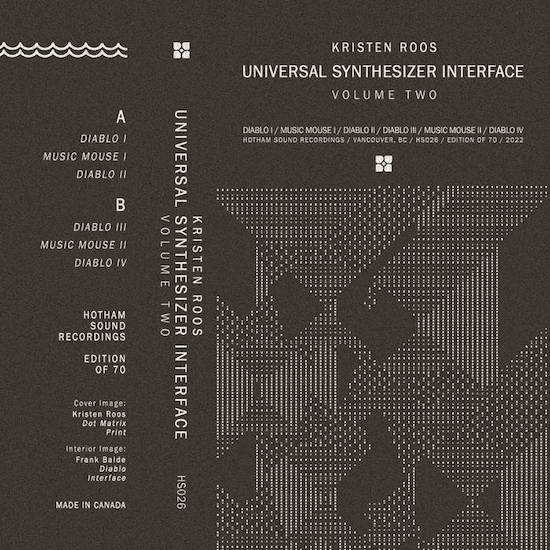Kristen Roos crafts vast musical networks from the restrictions of vintage technology. The Vancouver-based composer’s recent pieces stem from early algorithmic programs, using them to sculpt his far-reaching patterns. On Universal Synthesizer Interface Volume II, he writes with Laurie Spiegel’s Music Mouse and Frank Balde’s Diablo, balancing the rigor and structure of his looping phrases with a wide-eyed sense of curiosity.
Universal Synthesizer Interface Volume II acts as a companion to 2021’s Universal Synthesizer Interface Volume I, which offered a smattering of experiments with a couple of vintage MIDI software programs, exploring the different sounds he could make with them. With Volume II, Roos crafts a celebration of and an ode to Spiegel and Balde – it’s no surprise, considering Music Mouse and Diablo have become two of his favorite programs to tinker with. But while the album acts as a homage to two musical titans, and its derivations are evident, Roos’s carefully woven textures built from contrasting sounds offer a hypnotic glimpse into the possibilities that still exist with vintage technology.
Roos’s pieces expand from a simple, short melody that revs its engine and picks up more passengers with every repetition, stretching out in expansive swaths or pointillistic webs. The sprawling ‘Diablo II’ grows from a peppy rhythm into an enrapturing mix of staccato pulses and drifting, feathery beats, and though these textures contrast, they still fold together seamlessly, moving with ease and precision. Elsewhere, Roos trades fast-paced, swirling riffs for clarity. On ‘Music Mouse II’, he opts for slower and rounder beats and ample bouts of empty space, filling in the gaps like a puzzle slowly taking shape. Here, instead of enveloping with sweeping strokes, Roos’s melodies ping-pong off each other and collide into a mass of prickly textures.
Roos opts to use technology to make intricate grids, but even in the music’s most complex moments, he finds a sense of lightness and airiness. On ‘Music Mouse I’, his patterns feel like they’re prancing, hopping through a meadow made of lush sound; on ‘Diablo IV’, his bell-like sounds wobble and tumble out, never quite reaching the ground. Though the programs he experiments with have restrictions, and the music he makes requires exactitude, Roos showcases its playfulness, too. His music moves beyond just the nuts-and-bolts of this technology – it unearths the spirit inside of it and captures the wonder that comes with trying something new, even when it’s an old program.


